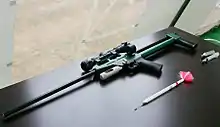Tranquillizer gun
A tranquillizer gun (also spelled tranquilizer, tranquilliser or tranquiliser), capture gun or dart gun, is a non-lethal air gun used to reduce irritability or agitation in animals via anesthetic drugs commonly referred to as tranquilizers.[1] The gun shoots a dart tipped with a hypodermic needle and filled with a dose of tranquilizer solution that is either sedative, comatosing[2] or paralytic. The gun makes it possible for wild animals to be sedated, while domestic animals are sedated in the same manner that humans are.


"Dart gun" can also mean a gun firing a dart which contains a vaccine or antibiotic.[3][4]
History
The modern tranquillizer gun was invented in the 1950s by New Zealander Colin Murdoch.[5] While working with colleagues to study populations of deer and wild goats introduced to New Zealand, he considered that the animals would be easier to catch, examine, and release if a dose of tranquillizer could be administered by projection from afar. To that end, Murdoch went on to develop a range of rifles, darts, and pistols.
The first modern remote drug-delivery system was invented by scientists at the University of Georgia in the 1950s, and was the direct predecessor to the Cap-Chur equipment used worldwide for decades.[6]
In the early 1960s, a team in Kenya headed by Drs. Tony Pooley and Toni Harthoorn discovered that various species, despite being of roughly equal size (for example, the rhinoceros and the buffalo), needed very different doses and spectra of drugs to safely immobilize them.
Characteristics
The dart, usually .50 caliber (12.7 mm), is a ballistic syringe loaded with an immobilizing agent and tipped with a hypodermic needle. The dart is propelled from the gun by compressed gas, and it is stabilized in flight by a tailpiece consisting of a tuft of fibrous material. The needle may be plain or collared, with a barb-like ring to improve retention of the needle and syringe for recovery from the target and to assure that the full dose is administered.
Methods of driving injection upon impact include: gas compression, spring compression, explosive charge, or gas evolution reaction.[7] In one example, compressed air or butane in the rear of the dart pressurizes the tranquillizer solution, while the needle is capped to hold the fluid in place. Upon striking the target, the cap is pierced by the needle as it punctures the animal's skin. With the pressure released, the compressed gas pushes the solution out of the syringe and into the target (see diagrams from Veterinary Technician).
Because of the power of the drugs, the handlers then have to move quickly to secure the animal for transport, monitor its vital signs, protect its eyes and ears, and then inject antidotes when needed. Many large animals are acutely sensitive to stress and can easily die without careful treatment; in order to counter stress in targeted animals, the gun is quiet, and there is usually a valve on the gun to control the dart velocity by varying the amount of gas pressure used to propel it.
Agents
Several immobilizing drugs have been devised for use in tranquillizer darts.[8] These include:
- Azaperone
- Combelen (Bayer)
- Domosedan (Farmos)
- Dormicum (midazolam) (Roche)
- Detomidine (Farmos)
- Fentanyl and Carfentanyl (Janssen Pharmaceutica)
- Etorphine hydrochloride (M–99, Novartis)
- Haloperidol (Kyron Laboratory)
- Immobilon, a mixture of etorphine and a phenothiazine tranquillizer such as acepromazine or methotrimeprazine.
- Ketamine
- Valium (diazepam) (Roche)
- Xylazine (Rompun, Bayer)
- Sodium Thiopental (Abbott)
Military and police use
Tranquillizer darts are not generally included in military or police less-than-lethal arsenals because no drug is yet known that would be quickly and reliably effective on humans without the risks of side effects or an overdose. This means that effective use requires an estimate of the weight of the target to be able to determine how many darts (if any) can be used. Shooting too few would result in partial effects only, while too many can kill the target. According to James Butts, former Chief of Police of Santa Monica, "Tranquilizing agents don't affect everyone uniformly. Therefore you cannot predict whether or not you have a sufficient dose to tranquilize the individual. Second, any tranquillizer will take time to enter the bloodstream and sedate the individual. If someone is advancing on you with a deadly weapon or a threatening object, there's no way a tranquillizer would take effect in the two to three seconds it would take someone to seriously injure you."[9]
References
- What is chemical capture? Archived 2006-04-26 at the Wayback Machine
- Anaesthetics also used in dart guns Archived 2009-10-06 at the Wayback Machine
- Veterinary Drugs & Dosages Table Archived 2020-12-22 at the Wayback Machine
- Olsen, S.C (19 May 2012). "Immune Responses and Safety after Dart or Booster Vaccination of Bison with Brucella abortus Strain RB51". American Society for Microbiology. Retrieved 22 December 2020.
- NZ Edge Heroes biography of Colin Murdoch
- Bush, Mitchell (1992). "Remote Drug Delivery Systems". Journal of Zoo and Wildlife Medicine. 23 (2): 159–180. JSTOR 20095205.
- Chancey, Erin. "Remote Injection Systems". VetFolio. Retrieved 31 Dec 2018.
- Tranquillizer agents Archived April 26, 2006, at the Wayback Machine
- Van Buren, Abigail (8 June 1997). "Tranquilizer Guns Could Do More Harm Than Good". Chicago Tribune. Retrieved 17 July 2017.
Further reading
- Harthoorn, Antonie Marinus (1970). The Flying Syringe. Bles.
- Harthoorn, Antonie Marinus (1976). The Chemical Capture of Animals. Baillière Tindall. ISBN 0702005584.
- Anti-personnel dart design - patent details
- Blow gun inoculating dart design - patent details